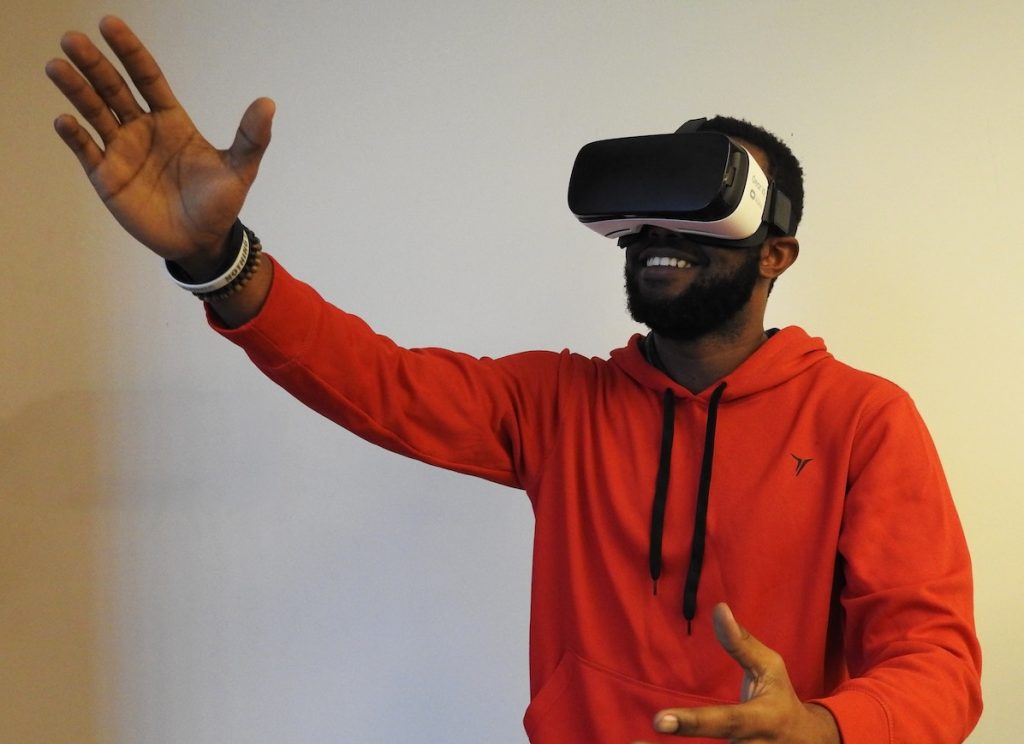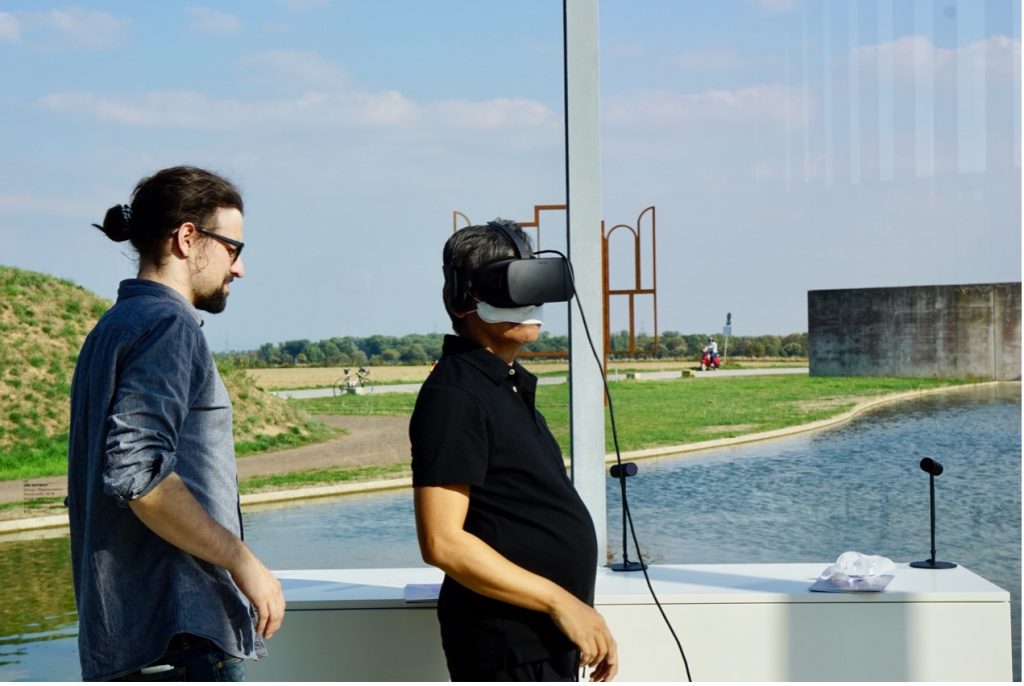
Everyday activities that most of us take for granted such as visiting shops, travelling on a bus, or walking in the street, can be intensely anxiety-provoking for some patients with psychosis (Freeman et al., 2022). Fear of being negatively judged, embarrassed, or rejected may lead those with psychosis to avoid these situations altogether.
When there is a marked fear of public places and attempts to actively avoid such situations, agoraphobia may develop (American Psychiatric Association, 2013). In the UK, one study found that 65% of 1,809 non-affective psychosis patients attending NHS mental health services had symptoms of agoraphobia (Freeman et al., 2019a).
gameChange, a virtual reality (VR) therapy, was developed to target psychosis patients’ anxiety towards everyday situations (Lambe et al., 2020). It allows patients to evaluate their fears in different scenarios with the help of a virtual coach.
The VR environment allows the treatment to be conducted in a controlled, modifiable, and engaging way. gameChange has demonstrated its effectiveness in reducing anxiety and distress in everyday situations for psychosis patients (Freeman et al., 2022 – blogged last year by Imogen Bell) and its potential use within psychiatric wards has been highlighted (Brown et al., 2022). Despite these promising findings, there is limited research on the potential side effects and patients’ experiences of VR for psychosis.

Virtual reality is an emerging technology for mental health treatments, including targeting anxiety in everyday situations among people with psychosis.
Methods
The study had a randomised controlled design with randomisation to either a VR cognitive treatment (gameChange) in addition to treatment as usual or just treatment as usual. The VR treatment lasted for thirty minutes and was continued over six sessions.
Participants were aged 16 or older, attended NHS services with a clinical diagnosis of schizophrenia spectrum psychosis or an affective diagnosis with psychotic symptoms measured using the ICD-10 (World Health Organization, 2004) and had difficulties being outside their home due to anxiety. The study was pre-registered and a protocol was published at the start of the trial (Freeman et al., 2019b).
The primary outcome measure was the Oxford Agoraphobic Avoidance Scale (O-AS) (Lambe et al., 2021). The O-AS measures anxiety and distress for everyday situations such as travelling on a bus or sitting in a GP waiting room. The results of this outcome measure were reported elsewhere (Freeman 2022).
Satisfaction and side effects were addressed using a battery of questionnaires specific to the domains (VR, agoraphobia, depression, hopelessness and psychosis).
The assessments were taken at baseline and six weeks and 26 weeks after randomisation.
Results
The study included 122 of the 161 trial participants who completed at least one VR session and provided outcome data.
Satisfaction with VR therapy
Almost all participants rated the quality of the VR therapy as good or excellent (98%), found the staff supporting them to be very helpful (98%), were either very satisfied or mostly satisfied with the VR therapy (97%) and were extremely likely or likely to recommend it to friends or family (91%).
Just over half of the participants said the VR therapy helped them to be more confident in everyday situations (51%) and over two-thirds felt they received just the right number of sessions (78%). Very few participants were dissatisfied with the VR therapy and rated the quality as fair (3%), that it didn’t really help (4%) or that it seemed to make things worse (1%). Only a few participants were indifferent/mildly dissatisfied (3%) or quite dissatisfied (1%) with the VR therapy.
Side effects
Potential side effects of the VR therapy were grouped into positive and negative items. The highest endorsement for a negative side effect was “I couldn’t concentrate on my session because I was constantly thinking about what else might be happening in the room” (14%) and for a positive side effect: “I felt proud of myself for being able to use the VR” (82%).
The side effects were grouped into four distinct factors for analysis: worries following VR, feelings of panic using VR, feeling valued and difficulties concentrating when wearing a headset.
There were no associations between baseline symptom scores (e.g., paranoia, voices, depression and anxiety) with the occurrence of side effects. The only statistically significant association with baseline measures was for participants that reported greater hopelessness, measured on the Beck Hopelessness Scale (Beck & Steer, 1988), that had fewer feelings of panic when in VR (R = -0.21, p = 0.028, n = 107).

Most patients were satisfied with gameChange Virtual Reality therapy and had minimal side effects.
Conclusions
Almost all participants in the study reported satisfaction with the VR therapy and positive experiences were more common than negative side effects. The authors believe that “over the coming years VR interventions are highly likely to be provided in clinical services for patients with psychosis.”
These findings were…
consistent with our clinical experience, and studies of patient and staff views (e.g., Bond et al., 2021; Brown et al., 2022) that indicate substantial enthusiasm for VR approaches or mental health difficulties.
The authors conclude:
Overall the study results indicate that patient experience will not hinder the implementation at scale of automated VR therapy but is instead more likely to prove a facilitator.
However, these data also show that we should be mindful of the potential side effects of VR therapy, and that not everyone may want to engage with VR therapy in the first place.

gameChange allows psychosis patients to experience everyday situations within virtual reality that they often find distressing in the real world.
Strengths and limitations
The study was of high quality, using a randomised controlled design with good allocation concealment. The report of the primary effectiveness outcome (the Oxford Agoraphobic Avoidance Scale) showed that it may be beneficial for psychosis patients (Freeman et al., 2022).
To ensure that the intervention was relevant to the target patient group, gameChange was designed with people with lived experience, and included support from mental health professionals.
However, the study participants had to have completed at least one VR session. This may have skewed the findings in favour of positive attitudes towards the technology.
Another limitation, as noted by the authors, is the use of a new measure created by clinical psychologists from the University of Oxford (Oxford – VR Side Effects Checklist). Further studies using the measure are required to confirm its validity, including a larger sample size to test for polytomous and dichotomous responses. It may have been helpful to compare the VR therapy with a VR control group rather than only treatment as usual, to help isolate the VR experience from the therapy being delivered (Schroeder et al., 2022).

This study reinforced the idea that virtual reality environments offer a safe, controlled space for psychosis patients to receive therapy.
Implications for practice
VR may be an effective environment for psychosis patients with agoraphobia. Although patients are aware that VR environments are not real, they very closely match real-world experiences and allow for greater engagement with treatment (Lambe et al., 2020). Psychosis patients are more likely to enter situations within VR that they would otherwise find incredibly distressing in the real world and this allows a safe space for experimentation (Lambe et al., 2020).
Shortly after this study was published, a further trial reported that gameChange was effective in reducing distress and anxiety from agoraphobia, and feedback from patients was positive (Freeman et al., 2022).
Side effects from VR could be a barrier to more widespread adoption of the technology. Clinicians, researchers and service users should be informed about, and on the lookout for side effects during this therapy.
Headaches and nausea can occur, especially when using the technology for the first time, but they were a minor complaint for psychosis patients in this study.
The authors note that:
The unpleasantness of cybersickness could be the side effect that most limits widespread adoption of VR.
There was no indication that this was at a scale to affect adoption significantly.

VR interventions are likely to be provided in clinical services in the future, thus patients should be informed of the benefits and side effects compared with traditional treatments.
Not everyone who is offered VR therapy will want to engage with it. We should not neglect this group.
As VR becomes more widespread within mental health therapy, it will be interesting to gather observational data from practice, and investigate whether other forms of interactive therapy can be beneficial, for example, those delivered through interactive 2D screens (Riches et al., 2021).
Statement of interests
None to disclose.
Links
Primary paper
Freeman, D., Rosebrock, L., Waite, F., Loe, B. S., Kabir, T., Petit, A., Dudley, R., Chapman, K., Morrison, A., O’Regan, E., Aynsworth, C., Jones, J., Murphy, E., Powling, R., Peel, H., Walker, H., Byrne, R., Freeman, J., Rovira, A., Galal, U., Yu, L.-M., Clark, D. M., & Lambe, S. (2022). Virtual reality (VR) therapy for patients with psychosis: satisfaction and side effects. Psychological Medicine, 1-12. https://doi.org/10.1017/S0033291722001167
Other references
American Psychiatric Association. (2013). Diagnostic and Statistical Manual of Mental Disorders: DSM-5. American Psychiatric Association.
Beck, A. T., & Steer, R. A. (1988). Manual for the Beck hopelessness scale. Psychological Corp.
Bond, J., Robotham, D., Kenny, A., Pinfold, V., Kabir, T., Andleeb, H., Larkin, M., Martin, J. L., Brown, S., Bergin, A. D., Petit, A., Rosebrock, L., Lambe, S., Freeman, D., & Waite, F. (2021). Automated virtual reality cognitive therapy for people with psychosis: protocol for a qualitative investigation using peer research methods. JMIR Research Protocols, 10(10), e31742. https://doi.org/10.2196/31742
Brown, P., Waite, F., Lambe, S., Jones, J., Jenner, L., Diamond, R., & Freeman, D. (2022). Automated virtual reality cognitive therapy (gameChange) in inpatient psychiatric wards: qualitative study of staff and patient views using an implementation framework. JMIR Form Res, 6(4), e34225. https://doi.org/10.2196/34225
Freeman, D., Lambe, S., Kabir, T., Petit, A., Rosebrock, L., Yu, L.-M., Dudley, R., Chapman, K., Morrison, A., O’Regan, E., Aynsworth, C., Jones, J., Murphy, E., Powling, R., Galal, U., Grabey, J., Rovira, A., Martin, J., Hollis, C., Clark, D. M., Waite, F., Altunkaya, J., Andleeb, H., Bergin, A., Bold, E., Bond, J., Bransby-Adams, K., Brown, S., Chan, C., Chauhan, N., Craven, M., Freeman, J., Geddes, J., Goodsell, A., Jenner, L., Kenny, A., Leal, J., Mitchell, J., Peel, H., Pervez, M., Prouten, E., Roberts, E., Robotham, D., Walker, H., & West, J. (2022). Automated virtual reality therapy to treat agoraphobic avoidance and distress in patients with psychosis (gameChange): a multicentre, parallel-group, single-blind, randomised, controlled trial in England with mediation and moderation analyses. The Lancet Psychiatry, 9(5), 375-388. https://doi.org/10.1016/S2215-0366(22)00060-8
Freeman, D., Taylor, K. M., Molodynski, A., & Waite, F. (2019a). Treatable clinical intervention targets for patients with schizophrenia. Schizophrenia Research, 211, 44-50. https://doi.org/10.1016/j.schres.2019.07.016
Freeman, D., Yu, L.-M., Kabir, T., Martin, J., Craven, M., Leal, J., Lambe, S., Brown, S., Morrison, A., Chapman, K., Dudley, R., O’Regan, E., Rovira, A., Goodsell, A., Rosebrock, L., Bergin, A., Cryer, T. L., Robotham, D., Andleeb, H., Geddes, J. R., Hollis, C., Clark, D. M., & Waite, F. (2019b). Automated virtual reality (VR) cognitive therapy for patients with psychosis: study protocol for a single-blind parallel group randomised controlled trial (gameChange). BMJ Open, 9(8), e031606. https://doi.org/10.1136/bmjopen-2019-031606
Lambe, S., Bird, J. C., Loe, B. S., Rosebrock, L., Kabir, T., Petit, A., Mulhall, S., Jenner, L., Aynsworth, C., Murphy, E., Jones, J., Powling, R., Chapman, K., Dudley, R., Morrison, A., Regan, E. O., Yu, L.-M., Clark, D., Waite, F., & Freeman, D. (2021). The Oxford Agoraphobic Avoidance Scale. Psychological Medicine, 53(4), 1233-1243. https://doi.org/10.1017/S0033291721002713
Lambe, S., Knight, I., Kabir, T., West, J., Patel, R., Lister, R., Rosebrock, L., Rovira, A., Garnish, B., Freeman, J., M. Clark, D., Waite, F., & Freeman, D. (2020). Developing an automated VR cognitive treatment for psychosis: gameChange VR therapy. Journal of Behavioral and Cognitive Therapy, 30(1), 33-40. https://doi.org/10.1016/j.jbct.2019.12.001
Riches, S., Pisani, S., Bird, L., Rus-Calafell, M., Garety, P., & Valmaggia, L. (2021). Virtual reality-based assessment and treatment of social functioning impairments in psychosis: a systematic review. International Review of Psychiatry, 33(3), 337-362. https://doi.org/10.1080/09540261.2021.1918648
Schroeder, A. H., Bogie, B. J. M., Rahman, T. T., Thérond, A., Matheson, H., & Guimond, S. (2022). Feasibility and efficacy of virtual reality interventions to improve psychosocial functioning in psychosis: systematic review. JMIR Mental Health, 9(2), e28502. https://doi.org/10.2196/28502
World Health Organization. (2004). ICD-10: International statistical classification of diseases and related health problems: Tenth revision (2nd ed.). World Health Organization.
Photo credits
- Photo by Hammer & Tusk on Unsplash
- Photo by Vinicius “amnx” Amano on Unsplash
